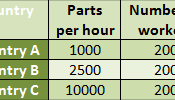Competitions between countries striving for trade surpluses have led to a number of scholars to establish various schools of thoughts, which could be utilized by government and large multinational corporations to decide on trade policies and seek best business investment opportunities.
In the 18th Century, Adam Smith published his famous Wealth of Nations (1776). Smith's theory, Theory of Absolute Advantage was the first to explain why unrestricted free trade is beneficial to a country. Free trade occurs when a government does not attempt to influence through quotas or duties what its citizens can buy from another country or what they can produce and sell to another country. Smith argued that the invisible hand of the market mechanism, rather than government policy, should determine what a country imports and what it exports. His arguments implied that such a laissez-faire stance toward trade was in the best interests of a country.
Building on Smith's work are three additional theories that we shall review.
One is The Theory of Comparative Advantage, advanced by the 19th century English economist David Ricardo: Principles of Political Economy (1817). This theory is the intellectual basis of the modern argument for unrestricted free trade.
In the 20th century, Ricardo's work was refined by two Swedish economists, Eli Heckscher and Bertil Ohlin, whose theory is known as the Heckscher-Ohlin theory (1919). The theory thus focuses on differences in relative factor endowment, rather than differences in relative productivity.
Then, in the end 20th Century, Michael Porter suggested a Porter's Diamond Theory (Harvard Business School, 1990). Porter states that international success in a particular industry is determined by four broad mutually reinforcing factors which create an environment which enables these firms to compete. The four include factor conditions, demand conditions, related and supporting industries and firm structure, strategy and rivalry. Chance...


